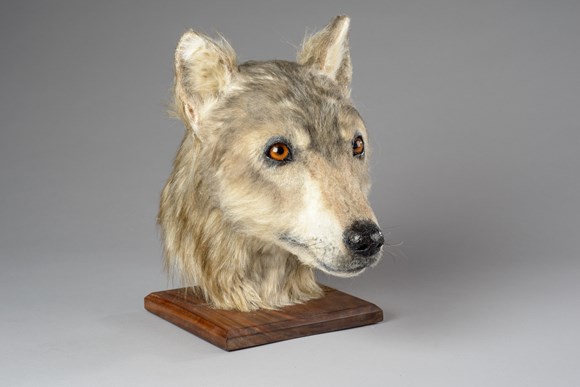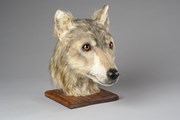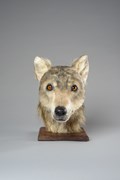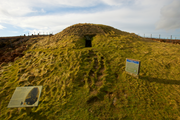
13 April 2019, 10:54
Forensic reconstruction reveals face of man’s ancient four-legged friend

Model created from dog skull discovered at Cuween Hill Chambered Cairn, Orkney
A reconstruction, commissioned by Historic Environment Scotland (HES), has revealed the face of a Neolithic dog for the first time in over 4,000 years.
The reconstruction has been created from the skull of a dog discovered in Cuween Hill chambered cairn on Orkney.
The canine skull, now in the collection of National Museums Scotland, was CT- scanned by staff in the Diagnostic Imaging Service at Edinburgh University’s Royal (Dick) School of Veterinary Studies. This enabled HES’s Digital Documentation team to make a 3D print, which was in turn used by forensic artist Amy Thornton to create a realistic model of the dog’s head, building up muscle, skin and hair in the same way she would approach a human head.
In all, 24 skulls were discovered when the site was excavated in 1901. Radiocarbon dating of the dog bones unearthed at Cuween has shown that the dogs were placed in the chamber more than 500 years after the passage tomb was built, suggesting that they were ritually buried.
Steve Farrar, Interpretation Manager at HES, said: “Just as they’re treasured pets today, dogs clearly had an important place in Neolithic Orkney, as they were kept and trained as pets and guards and perhaps used by farmers to help tend sheep.
“But the remains discovered at Cuween Hill suggest that dogs had a particularly special significance for the farmers who lived around and used the tomb about 4,500 years ago. Maybe dogs were their symbol or totem, perhaps they thought of themselves as the ‘dog people’.
“While reconstructions have previously been made of people from the Neolithic era, we do not know of any previous attempt to forensically reconstruct an animal from this time.
“Looking at this dog helps us better relate to the people who cared for and venerated these animals, people whose ingenuity and sophistication made Orkney such an important place in the Neolithic and who have left us with such a rich legacy of monuments today.”
Amy Thornton, who trained in facial reconstruction methods while undertaking an MSc in Forensic Art at the University of Dundee, said: “This reconstruction has been a particularly interesting project to be involved in, as it marks the first time I’ve employed forensic methods that would usually be used for a human facial reconstruction and applied these to an animal skull.
“This brought its own set of challenges, as there is much less existing data relating to average tissue depths in canine skulls compared to humans.
“The reconstruction was originally created in clay using traditional methods, with a 3D print of the Cuween Hill skull as the base to build the anatomy on to. The completed sculpture was then cast in silicone and finished with the fur coat resembling a European grey wolf, as advised by experts. The resulting model gives us a fascinating glimpse at this ancient animal.”
The original skull used to create the model is held at National Museums Scotland. Dr Alison Sheridan, Principal Archaeological Research Curator in the Department of Scottish History and Archaeology at National Museums Scotland, said: “We are delighted to have collaborated with HES on this very important initiative, which enables people to encounter a Neolithic dog ‘in the flesh’. The size of a large collie, and with features reminiscent of that of a European grey wolf, the Cuween dog has much to tell us, not only about ceremonial practices and the symbolic significance of the dog in Late Neolithic Orkney but also about the appearance of domestic dogs in the third millennium BC.”
The canine reconstruction is part of a wider project to use cutting-edge technology to share the stories of Orkney’s Neolithic chambered tombs with visitors. Last year, HES published 3D digital models of these chambered cairns, created through photogrammetry to better reveal the sophisticated structure of these monuments with the public. This process involves taking hundreds of overlapping images which are then combined to create a 3D model, enabling users from anywhere in the world to explore the sites in detail online.
All of this new research will form part of updated interpretation panels for visitors to Orkney’s chambered cairns, including Cuween Hill, due to be installed this summer. The reconstruction itself will also be going on display in Orkney later this year.
Ends
Contact Information
Claire Mullaney
Senior Communications Officer
Historic Environment Scotland
07881 512 379
claire.mullaney@hes.scot
Out of hours: mediaoffice@hes.scot or 07721 959 962
Notes to editors
About Cuween Hill chambered cairn
Cuween Hill chambered cairn, built between 3000 and 2400 BC, is an excellent example of a Neolithic chamber tomb. It has four cells opening off a central chamber, which is accessed down a passage. Entrance into the tomb today is through the original passage.
The cairn illustrates the sophistication of life among Scotland’s earliest agricultural communities, attesting to a belief in an afterlife 5,000 years ago with evidence of complex burial rites.
As well as the discovery of the skulls and bones of 24 dogs on the chamber floor, exploration at the tomb in 1901 also unearthed the remains of at least eight humans – five skulls on the floor of the chamber, one at the entrance and two in side cells.
Out of hours media enquiries:
Please call 07721 959 962 or email mediaoffice@hes.scot
About Historic Environment Scotland
- Historic Environment Scotland (HES) is the lead body for Scotland’s historic environment, a charity dedicated to the advancement of heritage, culture, education and environmental protection. It is at the forefront of researching and understanding the historic environment and addressing the impacts of climate change on its future, investigating and recording architectural and archaeological sites and landscapes across Scotland and caring for more than 300 properties of national importance. HES is also the lead on delivering Scotland's strategy for the historic environment, Our Past, Our Future.
- Historic Scotland, Stòr, trove.scot, The National Collection of Aerial Photography (NCAP), The Engine Shed, Stirling Castle and Edinburgh Castle are sub-brands of Historic Environment Scotland.
- Historic Environment Scotland is a registered Scottish Charity. Scottish Charity No. SC045925
- Keep up to date with news from Historic Environment Scotland and register for media release email alerts. You can unsubscribe at any time by following the unsubscribe link included in every email.
- You can follow Historic Environment Scotland on Facebook, Instagram, LinkedIn and our blog.




